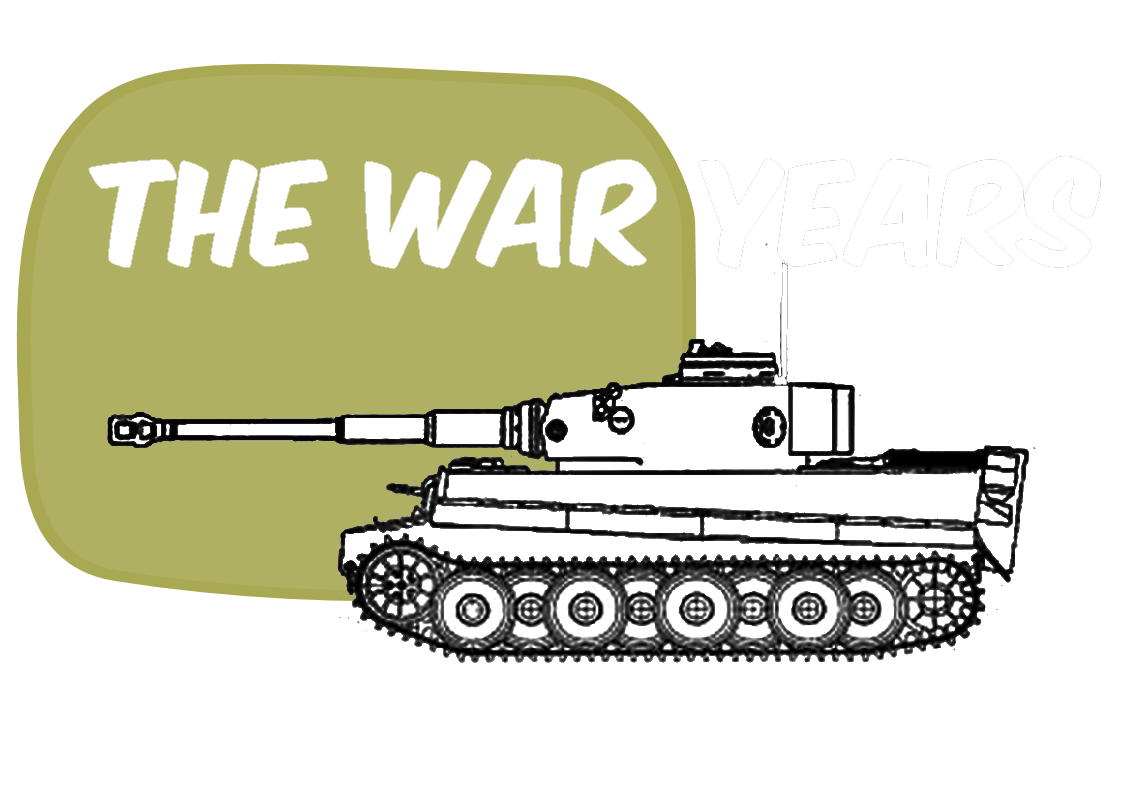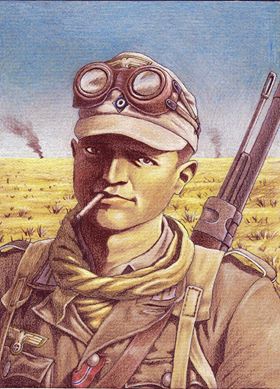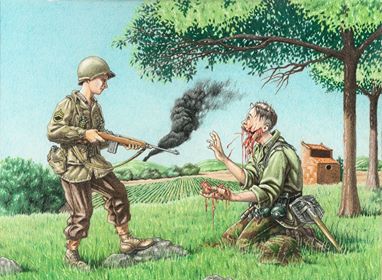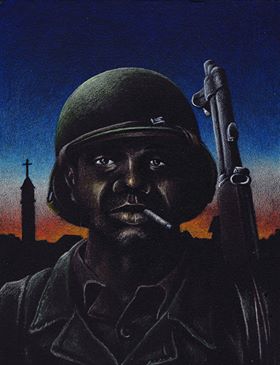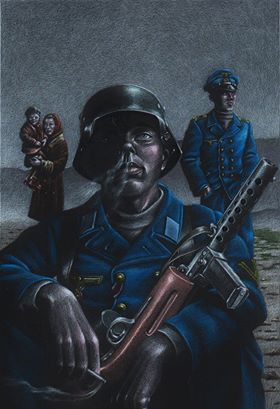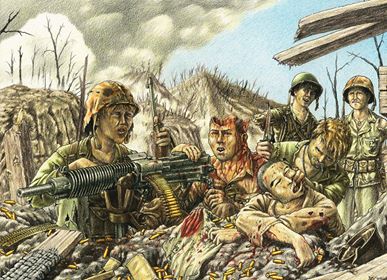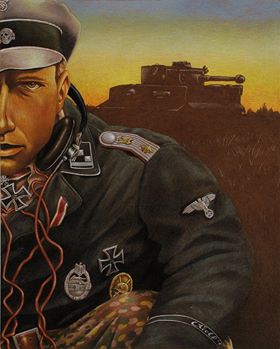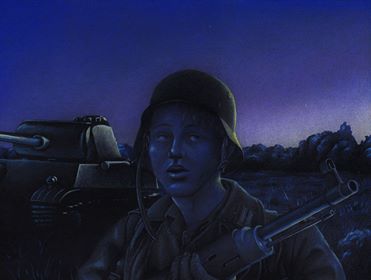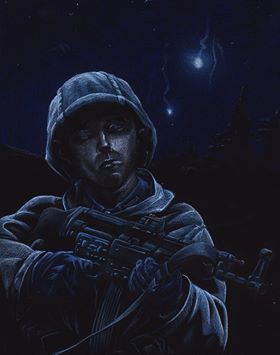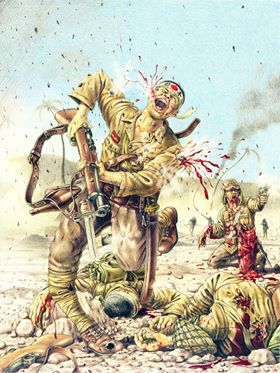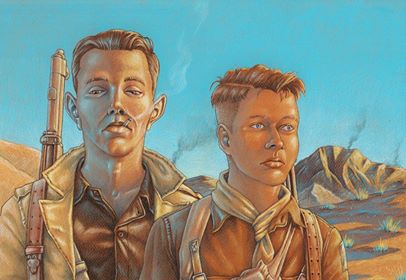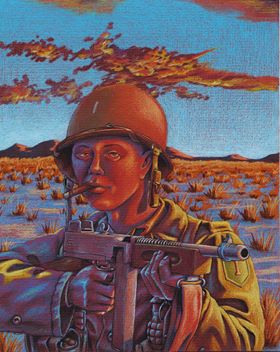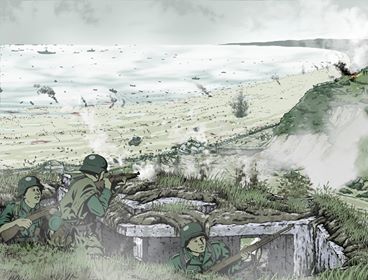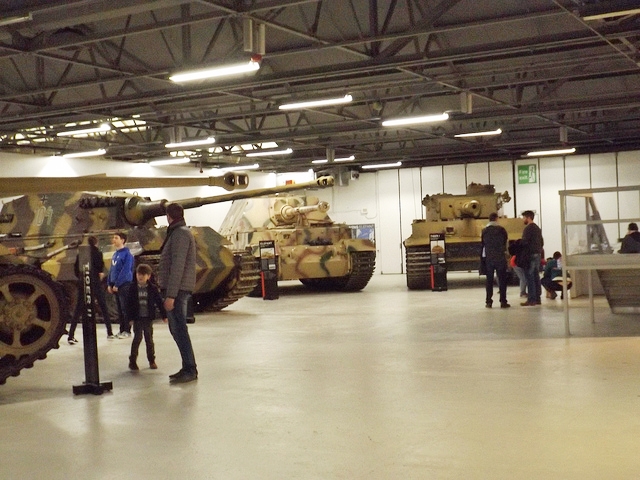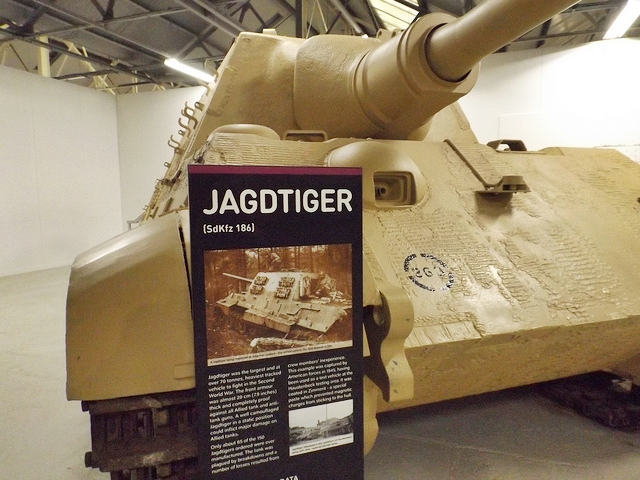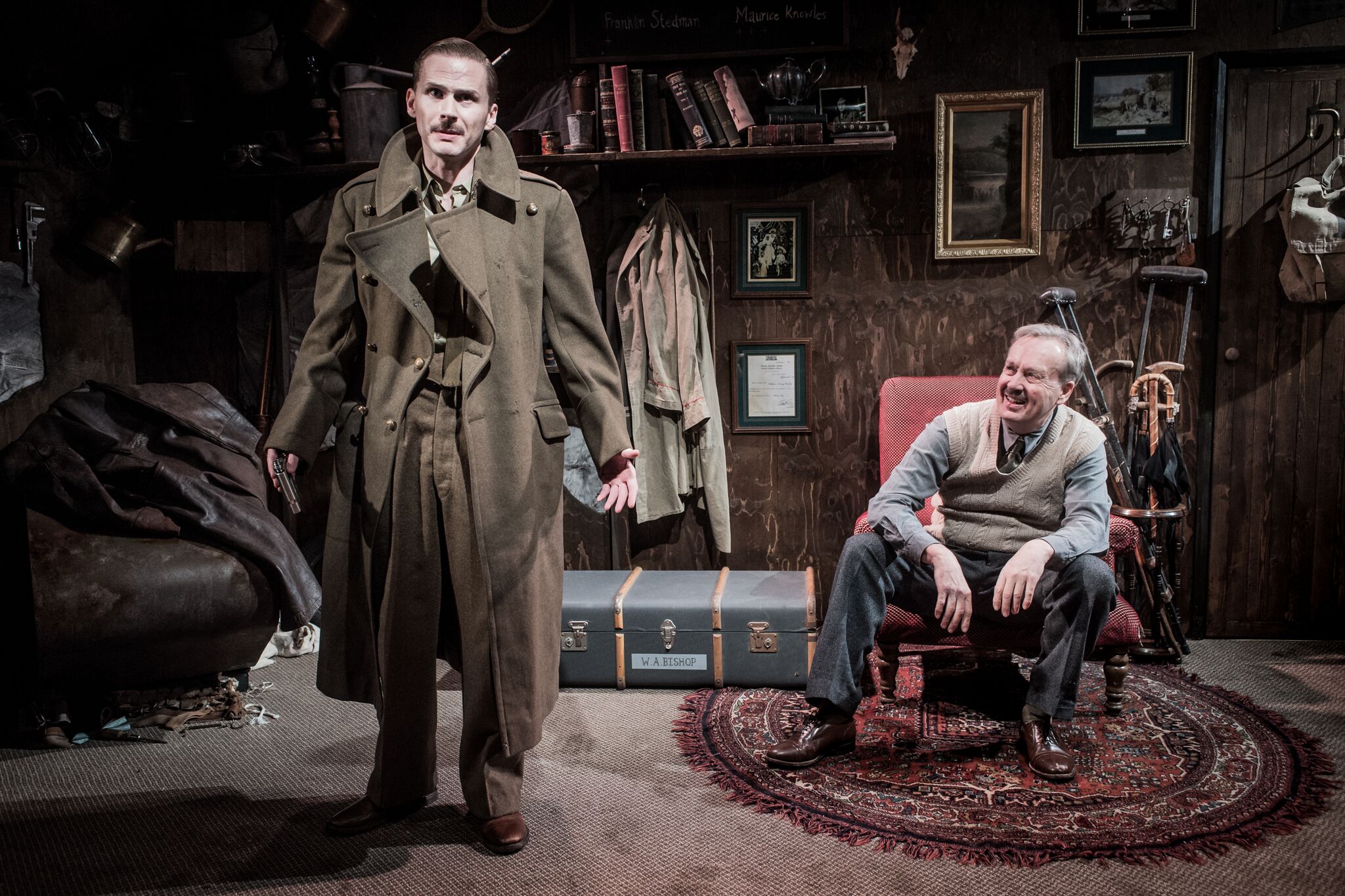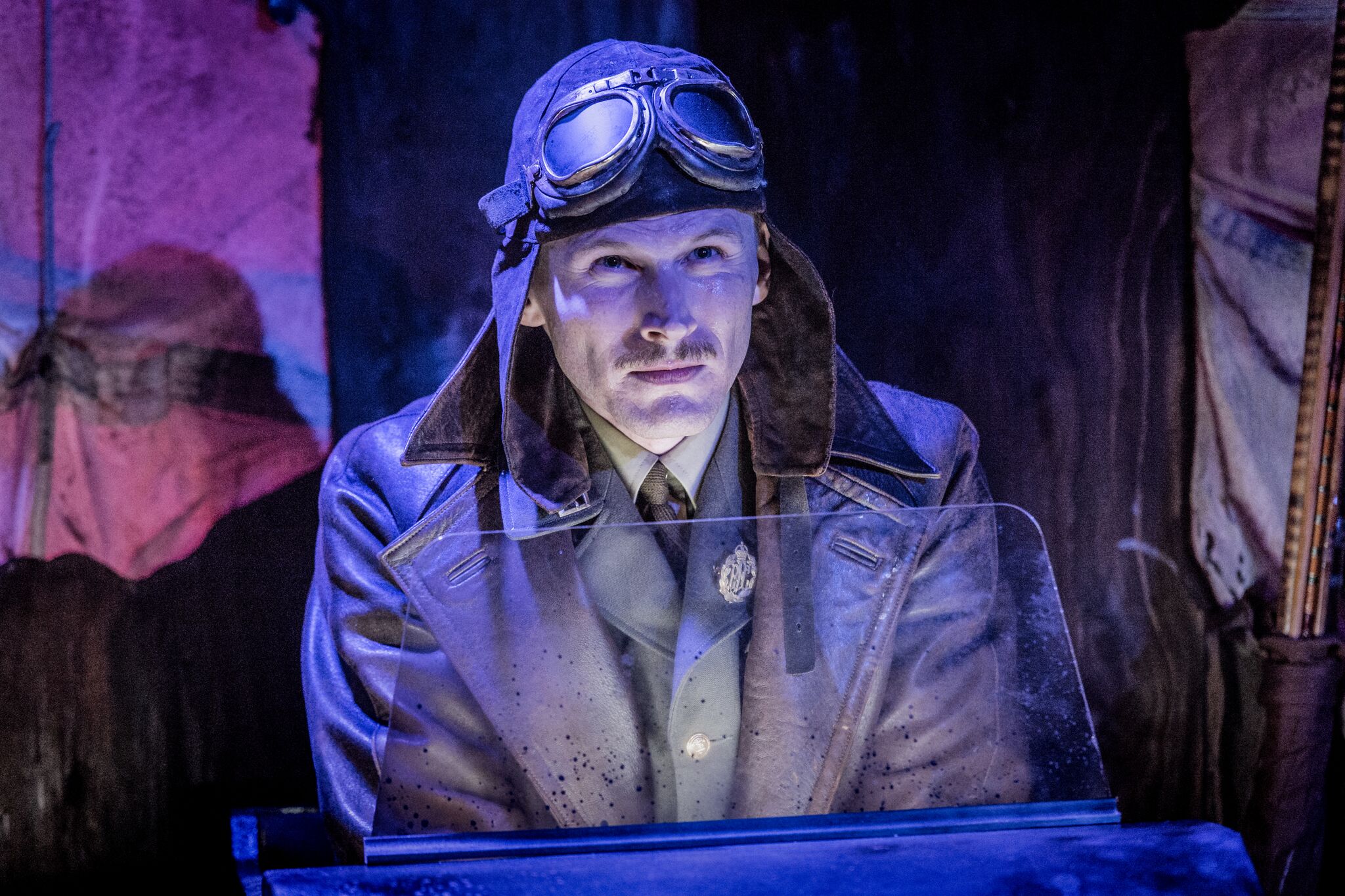
Blog
The Second World War resulted in the deaths of around 85 million people. Additionally, tens of millions more people were displaced. However, amid all the carnage, people demonstrated remarkable courage, fortitude, compassion, mercy and sacrifice. We want to honour and celebrate all of those people. In the War Years Blog, we examine the extraordinary experiences of individual service personnel. We also review military history books, events, and museums. We also look at the history of unique World War II artefacts, medals, and anything else of interest.
WW2 Artwork of Michael Akkerman
In this blog post, we showcase the emotive, World War Two-inspired artwork of Michael Akkerman from the famous faces of Audie Murphy and Eugene Sledge to the bloody realities of the battlefield.
Michael Akkerman is an American artist whose work is heavily influenced by World War Two (WW2) military history. Michael has kindly allowed The War Years to show some of his work here. Probably the most recognised subject of Michael’s work is Hollywood legend, Audie Murphy. He was one of the most decorated American soldiers of WW2, winning the Medal of Honor aged 19. After the war, Murphy had a successful acting career, as a songwriter and horse breeder. Sadly, he was killed in a plane crash in 1971. He was only 45 years old. One of Michael’s pictures is inspired by an episode taken from Murphy’s wartime autobiography, where he felt compelled to shoot a badly wounded young German soldier as an act of mercy.
Eugene Sledge is another name that will be familiar to many people with a passing interest in the Second World War. He served in the US 5th Marines, 1st Marine Division fighting in the Pacific. His book, ‘With the Old Breed: At Peleliu and Okinawa’ became a bestseller when published in the 1980s. His book and Robert Leckie’s ‘Helmet for My Pillow’, also served as inspiration for the HBO miniseries The Pacific. The savage, relentless fighting of the Pacific campaign had a dehumanising effect on many of the combatants. However, somehow, Eugene Sledge was able to hold onto his humanity amidst the horror, which is vividly illustrated in Michael Akkerman’s artwork.
Made famous by Nazi propaganda and a legend by the battle of Villers-Bocage, Michael Wittmann was a German tank ace with an impressive tally of 138 kills, mainly achieved on the Russian Front. He is also the subject of one of Michael Akkerman’s paintings. A week after the D-Day landings, SS-Hauptsturmführer Wittmann and his Tiger tank bumped into the forward elements of the British 7th Armoured Division. Wittmann attacked the British column and destroyed 14 tanks, 15 personnel carriers and two anti-tank guns in an engagement that lasted about 15 minutes. Wittmann was awarded the Knight's Cross with Oak Leaves and Swords and became a propaganda star. However, he would be killed just two months later. His remains would not be found and positively identified until 1983.
As well as the famous and infamous, Michael Akkerman’s paintings capture some of the more mundane and human elements of the Second World War, from the black ‘Buffalo Soldiers’ of the US Army to the hardships of the North Africa campaign. He also depicts the bloody realities of the Japanese Banzai charge and the lethal efficiency of the German MG-42 machine guns used to defend Omaha Beach on D-Day. To learn more about Michael’s artwork or to get a quote for a commission, you can find him on Facebook.
Book Review: Courage After The Battle by Peter Jackson-Lee
Courage After The Battle written by ex-Royal Marine and Falklands veteran Peter Jackson-Lee is a book that takes the reader on a journey that most people will never experience. The book is a travelogue that explains how service men and women navigate their way from battlefield injury back to civilian life. Read the full book review now
Courage After The Battle written by ex-Royal Marine and Falklands veteran Peter Jackson-Lee is a book that takes the reader on a journey that most people will never experience. The book is a travelogue that explains how service men and women navigate their way from battlefield injury back to civilian life. The book also examines the history of battlefield medicine, mental healthcare, prosthetics, reconstructive surgery, politics and changes in social welfare. At turns, the book is inspiring, fascinating and deeply troubling.
The book takes a systematic look at what happens to service personnel from the moment they suffer a life-changing wound on the battlefield. It explains the process of evacuation, emergency trauma care and transition to the hospital. Next, the book explains the many different types of battlefield trauma: loss of limbs, facial disfigurement, deafness and blindness. The book also looks at various treatments available such as prosthetics and plastic surgery. However, it is the long shadow cast by mental health and social care issues such as post-traumatic stress disorder (PTSD), depression, drug addiction, alcohol abuse and homelessness that I found the most disturbing. The destructiveness of these hidden wounds, if not treated quickly, spreads out like a pressure wave damaging family, friends and wider society.
The final third of Peter Jackson-Lee’s book explains the covenant between the Armed Services, the Nation and UK Government. The book also lists around 150 national charities and other organisations that provide help and support to current service personnel, veterans and their families. The fact that over 70 pages of the book simply list charitable organisations that offer support is alarming. It demonstrates the betrayal of the Armed Forces Covenant, and the abject failure of government policies stretching back decades. In many ways, this book is the story of a shocking, perennial national disgrace.
The book is written in a balanced, no-nonsense, straightforward style and tone. Peter Jackson-Lee lets the veterans, families, healthcare professionals, charity workers and facts speak for themselves. He explains the history of every technical, medical and procedural advance that makes suffering a battlefield injury move survivable. However, while the overall survivability of battlefield injuries has steadily increased, the opposite is true of long-term care. Consecutive governments have overseen punitive cuts in the provision of everything from mental healthcare to housing, and much more besides.
From Trafalgar, Waterloo and the Battle of Britain to the Falklands, Iraq and Afghanistan, the Armed Services have always been there to protect this country’s national interests with their lives. Nevertheless, the compact between the State and its servicemen and women has always been an unequal one. Service personnel are expected to make the ultimate sacrifice without complaint when called upon to do so. In contrast, our politicians, the Ministry of Defence (MOD) and civil servants can renege on every promise and betray every commitment. While our service men and women are driven by loyalty, courage and comradeship, the politicians and bureaucrats are driven by arrogance, ignorance and greed.
Reading Courage After The Battle makes you ask the question, why would anyone join the Armed Services? In 2018, a National Audit Office (NAO) report found the Armed Services had a shortfall of 8,200 regulars (full-time service personnel). In December 2018, it was widely reported that a £495m contract with the outsourcing giant Capita had clearly failed to achieve the Army’s recruitment targets. What’s more, half of the Army’s applicants subsequently dropped out of the process. Another monumental waste of public money that could have been better spent elsewhere.
Interestingly, a Harvard Institute of Politics (IOP) survey found that while many millennials (18 to 29 years old) generally supported the US military’s war against Islamic State (ISIS), they themselves did not want to take part. One reason many millennials gave for not wanting to join the US military was a “deep distrust about all things relating to the government.” Clearly, books like Courage After The Battle can help today’s young people make better-informed decisions about joining the military, and the potential long-term consequences of doing so. The book also shines a light on the many shameful actions perpetrated by British politicians, civil servants and bureaucrats against our veterans and their families. Something to think about the next time you go to the polls.
Courage After The Battle is published by Brown Dog Books.
Face to Face with the German Tiger tank
In this article, we look at the merits and deficiencies of the German Tiger tank during World War Two, and the muddled strategic thinking that drove the project forward.
The Tiger tank (Panzerkampfwagen VI Tiger Ausf. E) entered service at the end of 1942. It was not a great start. The tank was deployed over unsuitable terrain, limiting its effectiveness. The early production Tigers were plagued with technical problems including dangerous engine fires. Many of these early teething problems were symptoms of the tank being rushed into service without adequate development and testing. However, the Tiger was also over-engineered. The result was a highly complex, often temperamental weapons system that required extensive preventative maintenance and careful handling.
Fighting the Wrong War
Manufactured by Henschel, the Tiger I Ausf. E was the product of creaky strategic thinking. The Tiger was not built in response to Soviet tanks like the T-34 and KV-1. Instead, the Tiger was designed as a “sledgehammer” to smash holes in the enemy’s lines, which support units could then exploit. However, the Germans were already fighting a largely defensive war by late 1942. The days of the blitzkrieg were over. A far better solution would have been to concentrate all manufacturing resources on producing the reliable, very effective Panzer IV main battle tank (MBT).
60 Tonne Sledgehammer
Although the Tiger had many deficiencies, it was not without merit. In the hands of a well-trained and experienced crew who understood the Tiger’s advantages, the tank could prove a formidable opponent. Tank design is about achieving the right balance of mobility, armour and firepower so the vehicle can perform its primary task. Clearly, the Tiger was designed as a sledgehammer, and that’s what the panzer forces got. The Tiger weighed in at just under 60 tonnes, with 100mm frontal armour, 80mm side and rear armour, two MG-34 machine guns, and a high velocity, flat trajectory 88mm main gun.
40 Percent Reliable
The Tiger’s 88mm main gun fired both armour piercing (AP) and high explosive (HE) shells. Officially, the tank could store 92 rounds. However, crews typically packed as many additional shells into every available space as possible. Although the tank was underpowered by the Maybach HL230 700-horsepower petrol engine, it was surprisingly quick and agile on good ground. A semi-automatic gearbox and steering wheel also made the tank easy to drive. Nevertheless, even when the tank was well maintained and supported by a good workshop company, the Tiger’s overall reliability was abysmal. Most Tiger Is were only operational 40 per cent of the time. The reliability of other Tiger variants such as Tiger II Ausf. B, Panzerjager and Jagdtiger were even worse.
Recovery No Easy Task
Naturally, broken down and battle-damaged tanks need to be recovered, whenever possible. Unfortunately, the Tiger’s size and weight often worked against easy recovery. Typically, it took two or three prime movers (tractors) to tow a Tiger to safety. Panzer units were under strict orders not to use one Tiger to tow another, as this could result in damaging the second tank. However, necessity often trumped orders and Tigers frequently towed one another. Later, specialist recovery tanks were introduced, such as the Bergepanther, but these vehicles were always in short supply.
The Importance of Training
How well or poorly an individual tank performs is mainly reliant on the quality and training of the crew. As the war progressed and losses mounted, the German army struggled to provide adequate manpower or training to its panzer forces. Subsequently, overall performance suffered. However, the Germans valued the lives of their panzer crews, and the Tiger provided a separate escape hatch for each man. Many Allied tanks were not designed as well, resulting in men being trapped inside burning vehicles after they had been hit. When it came to training Tiger crews, the official manual was surprisingly innovative. The Tigerfibel aimed to convey complex battlefield instructions in a simple and memorable manner to young recruits using cartoons, jokes and risqué pictures of women. Even today, you can buy a copy in English translation on Amazon.
The Unsinkable Tiger
Thanks to a combination of thick, seemingly impervious frontal armour, the legendary 88mm gun and copious amounts of Nazi propaganda, the Tiger quickly gained a reputation for impregnability. Of course, the Tiger was as impregnable as the Titanic was unsinkable. In reality, the Tiger’s main value came from its ability to stand off and deal with its opponents at a distance. However, even with mid and late-production improvements, by 1944 the Tiger was fighting a losing battle.
The Victory of Mass Production
The Germans went for quality over quantity in tank production, but a lack of time and resources meant they never really delivered on quality. They also chose to pursue an obsolete military strategy at odds with the realities of their situation. In contrast, the Allies went for simple, reliable vehicles they could mass-produce in vast quantities. Over 110,000 Soviet T-34 and American M4 Sherman medium tanks were manufactured compared with just over 1,300 Tiger I Ausf. E. That’s 85 to one, and only half the Tigers would be fit for service at any time. What’s more, the Allies didn’t stand still. They improved their existing tank forces and introduced new, heavier tanks. The British Comet, for example, entered service in December 1944. Ultimately, the Tiger only ever won the propaganda war. In all other respects, the Tiger was a costly, unreliable failure.
Review: Billy Bishop Goes to War at the Jermyn Street Theatre
In this blog post, we review the latest production of the musical drama Billy Bishop Goes to War at the Jermyn Street Theatre. The production recounts the extraordinary life and career of Canadian WW1 flying ace Billy Bishop. The play is running Wed, 31st October - Sat, 24th November 2018.
Usually, just two words would deter me from buying tickets to a show: musical theatre. So, it was with some trepidation that I accepted an invitation to watch the latest production of Billy Bishop Goes to War at the Jermyn Street Theatre, London. However, the moment actor Oliver Beamish began playing the piano and started to sing, I immediately knew I could strap myself in, sit back and enjoy the ride. In that tiny theatre, as intimate as any cockpit, with consummate professionals at the controls, we would navigate the career of WW1 Canadian flying ace Billy Bishop.
Written by John Gray with Eric Peterson, Bill Bishop Goes to War tells the wartime story of William (Billy) Avery Bishop during the period 1914 to 1917. The play also touches briefly on Billy’s military contribution during the Second World War. Billy made for an unlikely hero. He showed no promise as a young cadet at the Royal Military College of Canada (RMC), where he failed his first year and was caught cheating. He was somewhat accident-prone, and suffered bouts of stress-related illness. Nevertheless, he found himself commissioned as a cavalry officer and shipped across the North Atlantic to England in 1915. Two ships in his convoy were torpedoed by German U-boats with the loss of over 200 men.
While stationed in France during the summer of 1915, Billy transferred to the Royal Flying Corps (RFC) as an observer. In March 1917, he became a pilot joining the 60 Squadron at Filescamp Farm near Arras. At that time, the average life expectancy of a new pilot was just 11 days. Once again, Billy’s career as a pilot got off to a shaky start. He crash-landed his aircraft during a practice flight in front of General John Higgins. However, within a few short months, Billy was awarded the Victoria Cross for a solo attack against a German aerodrome. By August 1917, he had surpassed the late Albert Ball’s tally of “kills”. Billy was on his way to becoming one of the conflict’s greatest fighter aces. After a brief period of leave in Canada, where he got married, Billy returned to the fray. Eventually, he was promoted out of harm’s way as Officer Commanding-designate of the Canadian Air Force Section of the General Staff, Headquarters Overseas Military Forces of Canada. By the war’s end, he had claimed 72 aerial victories, including two balloons.
During World War Two, Billy Bishop was appointed Director of the Royal Canadian Air Force and placed in charge of recruitment. In 1942, he appeared as himself in the Hollywood movie Captains of the Clouds. In 1944, Billy’s old foe stress-related illness forced him to resign. He died in his sleep on 11 September 1956, aged 62.
The Jermyn Street Theatre is a small, subterranean gem. The intimacy of the space and excellent set design by Daisy Blower created the feeling of being in a First World War dugout. Packed with the memorabilia of the older Billy’s extraordinary life, even the most mundane items such as a suitcase and an old red armchair were transformed into meaningful props. In a time when audiences can be blasé about multi-million dollar movie special effects, it was wonderful to see a swinging lamplight create the illusion of movement as Billy crossed the ocean aboard the ship Caledonia. A vessel designed to ship cattle, not men.
First staged in 1978, this revival of Billy Bishop Goes to War has more than a touch of the BBC sitcom Blackadder Goes Forth. Directed by Jimmy Walters, this musical drama moved seamlessly between comedy and tragedy. Actors Charles Aitken and Oliver Beamish did a brilliant job of portraying Billy in his youth and later life. They immediately established a wonderful rapport with the audience. Oliver Beamish provided the piano and musical accompaniment while Charles Aitken brought amazing physical energy to the performance. The two actors played an additional 17 characters. I particularly liked Charles Aitken’s Lady St. Helier, Billy’s patron in London society. He seemed to be channelling actress Frances de la Tour.
As the Jermyn Street Theatre is a registered charity, I was a little disappointed that the small auditorium was not sold out, and about a third of the seats were empty. I was also surprised the production is only running until 24 November 2018. Just days before the centenary of the end of the First World War, Billy Bishop Goes to War reminds us of the immense courage, perseverance and sacrifice of ordinary men who served in the “Great War”. The drama also examines the tensions between the British establishment and its “colonial” cousins, who were good enough to fight and die for the empire while being widely regarded as second-class citizens. Overall, the show is a wonderful, poignant piece of musical theatre that teaches us ordinary people can do the most extraordinary things.
Production photography courtesy of Robert Workman
World War One Missing Manuscript Returns Home
In this book review we take a look at a lost manuscript of the Great War finally published. Field Dressing by Stretcher Bearer, France 1916 – 1919, is a slim volume of World War One poems by Alick Lewis Ellis. He served as a stretcher bearer with the 2/3rd London Field Ambulance, 54th Division, London Regiment, and took part in the Battle of the Somme, Arras, Ypres and Cambrai.
Field Dressing by Stretcher Bearer, France 1916 – 1919, is a slim volume of World War One poems by Alick Lewis Ellis. He served as a stretcher bearer with the 2/3rd London Field Ambulance, 54th Division, London Regiment, and took part in the Battle of the Somme, Arras, Ypres and Cambrai. During his time on the Western Front, Alick took to writing poetry to capture and make sense of his experiences. His notebook of poems was lost for nearly a hundred years until someone anonymously handed it to Dan Hill at the Herts at War Society in 2017. Dan Hill subsequently tracked down Alick’s remaining family, and together they worked to publish Field Dressing by Stretcher Bearer. To recognise the essential role played by the Royal Army Medical Corps (RAMC) and military mental health charities, a proportion of the book’s profits will go to Combat Stress and Veterans With Dogs.
Alick Lewis Ellis appears to have led an unremarkable life. He had a basic education and looked forward to a career as a grocer if the war had not intervened. His war poems might not have the literary complexity and construction of Wilfred Owen, Robert Graves and Siegfried Sassoon. Nevertheless, they have merit and share many common themes with the famous war poets of his generation. His poems reflect the direct experiences of war. They celebrate their comrades, condemn the war leaders, scorn the indifference of many civilians, and express a longing for home. Unfortunately, we know nothing of Alick’s creative influences or inspirations. The documentary of his life is reduced to a few faded photos, sketchy family memories and military service records.
Regardless of the many horrors and privations of the Western Front, Alick seems to have maintained his sense of humour. In poems like Revenge, he jokes about the quality of Army food, especially the rock-hard biscuits issued to the troops. In Training and Reality, he uses humour to illustrate just how poorly depot life and parade ground drill prepared soldiers for combat. After the war, Alick returned to working in retail, but little else about his life is known. Sadly, he passed away in November 1953. Alick’s poems might not be the greatest literary works, but they are honest, funny and poignant. Regrettably, they tell us familiar stories as old as war itself.
Billy Bishop Goes To War
In this blog, we share the official press release for the WWI musical-drama Billy Bishop Goes To War at the Jermyn Street Theatre, London, between 31st October and 24th November 2018. This striking drama is based upon the true story of young Billy Bishop, a failing military college student who became Canada’s indomitable flying ace, the most successful pilot of his generation.
Jermyn Street Theatre, 16b Jermyn Street, London SW1Y 6ST
Wednesday 31 October – Saturday 24 November 2018
Coinciding with the centenary of the end of World War I, Proud Haddock is reviving Billy Bishop Goes To War as part of their War Season and Jermyn Street Theatre’s Rebels Season. This striking drama is based upon the true story of young Billy Bishop, a failing military college student who became Canada’s indomitable flying ace, the most successful pilot of his generation.
Billy Bishop Goes To War will star Charles Aitken (The Knick, Cinemax; Happy Death Day, Universal Pictures; King Lear, Royal Shakespeare Company) as Billy Bishop with Oliver Beamish (Coronation Street, ITV; Blood Brothers, Lyric Theatre; War Horse, The New London Theatre) as the Older Billy Bishop, who will also provide the piano and musical accompaniment. Between them, they will play a further 17 parts as they recount this extraordinary tale.
In 1914, Billy Bishop, aged only 20, signed up to fight in the Great War. A failing and bullied student, he overcame intense prejudice and astonishing danger to receive his wings and become the top fighter pilot. Through a combination of bravery and sheer luck, Billy was able to find his place and prove his worth. He became a true Canadian hero.
Brought to life with songs of the period, Billy Bishop Goes To War vividly transports the audience across the landscape of World War I, from the thick mud of No Man’s Land to the drawing rooms of the British aristocracy. This compelling and darkly comic drama interrogates the nature of heroism and its cost while shining a light on the often-neglected complexities of Britain’s colonial past during the War.
Written by John MacLachlan Gray in collaboration with Eric Peterson, the play returns to London for the first time in over 35 years. Billy Bishop Goes To War is the deceptively moving and totally gripping account of one man’s life in World War I.
Director Jimmy Walters comments, Proud Haddock’s War Season continues with Billy Bishop Goes To War. This is a true story with lots of heart. Billy wasn’t the most academic student, was bullied at school and faced prejudice when he arrived in England during the First World War yet he overcame all of this to become the greatest fighter pilot of his generation. It’s an inspiring story that is a privilege to revive.
For more information download a copy of this press release.
To book ticket visit http://www.jermynstreettheatre.co.uk/. The play runs between Wednesday 31October and Saturday 24 November, 2018.
